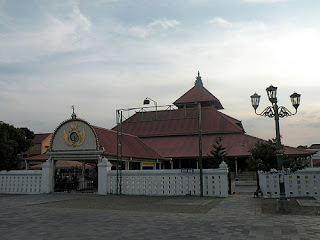LOCATION
Ratu Boko Palace located on the hilltop with a height of about 196 meters or more precisely 195,97 meters above sea level, occupies an area of 250,000 m2. Ratu Boko Palace is located on the Boko plateu, about 19 kilometers east of Yogyakarta city (toward Wonosari), and 2 km south of the Prambanan Temple.
From its location, Ratu Boko complex has a unique and special attraction, because of the complex which are located on hills can enjoy beautiful natural scenery and charming. On a hillside plateau, overlooking Prambanan temple complex and with a view to Mount Merapi behind Prambanan Temple complex. with a village atmosphere with green rice fields around it. In addition, the south, when the weather is sunny, in the distance, faintly visible to the South Coast.
Site Ratu Boko is the single largest classical period settlement site found in Java, especially Java middle section. This feature makes Ratu Boko as a specific site, a lot of mystery as well as a variety of interesting phenomena to be traced and revealed.
HISTORY
Historical background Keraton Ratu Boko can not be known for certain, but to be able to reveal not only used non-textual data (buildings, statues, ceramics, artifacts, etc.) are also used textual data due to findings of the inscriptions.
From inscriptions that can be concluded that the region is a region Ratu Boko heritage character of Hinduism and Buddhism, which was built around VIII - IX sentury. Ratu Boko complex was originally a monastery complex, which is a dormitory for the residence of the monks in the Buddhist religion.
In the year 856 AD, Ratu Boko complex functions turn into the residence of a ruler called the Rakai Wilang Pu Khumbayoni the adoption of Hinduism. It is therefore not surprising that elements of Hinduism and Buddhism looks at this building complex.
Elements of Hinduism can be shown through the yoni, three miniature temples, statues of Ganesh and Durga as well as gold and silver plate that read Hindu religious incantation, while the Buddhist elements visible from the discovery of Buddha statues, ruins of stupas and stupika.
The folklore of Loro Djonggrang
This story connects the Ratu Boko Palace with the Prambanan and Sewu temple complex. The name of King Boko comes from Javanese Folklore, in which King Boko was the father of Loro Djonggrang.
A prince named Bandung desperately wanted Loro Djonggang to marry him and she refused, as she he had killed her father. He insisted, and she finally agreed on one condition. He must build 1000 temples in one night. Prince Bandung summoned up spirits to help him, and close to dawn, much to the dismay of Loro Djonggrang they had completed the 999th temple. Loro Djonggrang ordered all of the servants to light a large fire, and begin pounding rice. The roosters were fooled into thinking it was dawn and began to crow, the spirits fled, and the final temple was left unbuilt. Prince Bandung was furious and turned Loro Djonggrang into stone, representing the final temple.
According to the traditions, she is the image of Durga in the north cell of the Shiva temple at prambanan, which is also known as Loro Jonggrang or the Slender Virgin.
According to the traditions, she is the image of Durga in the north cell of the Shiva temple at prambanan, which is also known as Loro Jonggrang or the Slender Virgin.
TATA LETAK
Menurut lokasinya, bangunan-bangunan di situs Ratu Boko dibagi menjadi 5 bagian, yaitu :
1. Kelompok Gapura Utama
Gapura Utama terletak di sebelah barat yang terdiri dari gugusan Gapura Utama I dan II, talud, pagar, candi pembakaran, dan sisa-sisa reruntuhan.
2. Kelompok Paseban
Terdiri dari dua buah batur paseban, talud dan pagar paseban, termasuk gapura dan beberapa umpak batu.
3. Kelompok Keputren
Berada di halaman yang lebih rendah, terdiri dari dua buah batur, kolam segi empat, pagar dan gapura.
4. Kelompok Pendapa
Terdiri dari batur pendapa dan pringgitan yang dikelilingi pagar batu dengan tiga gapura sebagai pintu masuk, candi miniature yang dikelilingi teras-teras segi empat, beberapa kolam penampung air yang dikelilingi pagar lengkap dengan gapura dan struktur talud yang diberi pagar dibagian atasnya.
5. Kelompok gua
Terdiri dari Gua Lanang, Gua Wadon, bak tendon air, dan tangga batu cadas alam.
LAYOUT
According to its location, the buildings on the site Ratu Boko is divided into 5 parts, namely:
1. Main Gate group.
Main Gate is locatedto the west of of Main Gate cluster I and II ,talud ,fences ,burn the temple ,and remains of rubble .
2. Paseban group
Consisting of two shelf paseban, talud and fence paseban, including gates and some stone base.
3. Keputren group.
Being in a lower page, consists of two shelf, rectangular pool, fence and gate.
4. Pendapa group.
Consisting of shelf pendapa and pringgitan stone surrounded by a fence with three gates as the entrance, the temple is surrounded by miniature rectangular terraces, some pond water reservoir surrounded by a fence complete with gate and fences fed talud structure on top of it.
5. Cave group
Consisting of Lana Cave, Cave Wadon, tendons water bath, and natural rock staircase.
ACCOMODATION
Ratu Boko is located 3km south of the Prambanan complex and east of Yogyakarta, off the road to Solo.
This way you can also have transport ready to take you back when you are ready to head back. The other alternatives are a tour group mini-bus, or even a taxi.
This way you can also have transport ready to take you back when you are ready to head back. The other alternatives are a tour group mini-bus, or even a taxi.
Tickets are available at the official ticket booth at the entrance
The fees are as follows:
The fees are as follows:
Indonesian local or KITAS card holder, weekday | 10 000 Rupiah |
Indonesian local or KITAS card holder, weekend | 12 500 Rupiah |
Foreigner | $10 US |
Foreigner - registered student | $6 US |





















